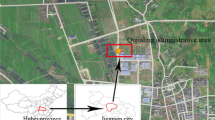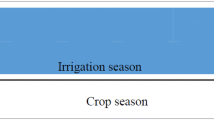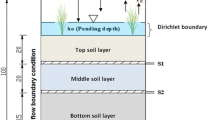Abstract
Agricultural non-point source pollution is a major factor in surface water and groundwater pollution, especially for nitrogen (N) pollution. In this paper, an experiment was conducted in a direct-seeded paddy field under traditional continuously flooded irrigation (CFI). The water movement and N transport and transformation were simulated via the Hydrus-1D model, and the model was calibrated using field measurements. The model had a total water balance error of 0.236 cm and a relative error (error/input total water) of 0.23%. For the solute transport model, the N balance error and relative error (error/input total N) were 0.36 kg ha−1 and 0.40%, respectively. The study results indicate that the plow pan plays a crucial role in vertical water movement in paddy fields. Water flow was mainly lost through surface runoff and underground drainage, with proportions to total input water of 32.33 and 42.58%, respectively. The water productivity in the study was 0.36 kg m−3. The simulated N concentration results revealed that ammonia was the main form in rice uptake (95% of total N uptake), and its concentration was much larger than for nitrate under CFI. Denitrification and volatilization were the main losses, with proportions to total consumption of 23.18 and 14.49%, respectively. Leaching (10.28%) and surface runoff loss (2.05%) were the main losses of N pushed out of the system by water. Hydrus-1D simulation was an effective method to predict water flow and N concentrations in the three different forms. The study provides results that could be used to guide water and fertilization management and field results for numerical studies of water flow and N transport and transformation in the future.









Similar content being viewed by others
References
Allen RG, Pereira LS, Raes D, Smith M (1998) Crop evapotranspiration-guidelines for computing crop water requirements. In: FAO Irrigation and Drainage. Food and Agriculture Organization (FAO) of the United Nations, Rome, Italy, pp 56
Aulakh MS, Singh B (1997) Nitrogen losses and fertilizer N use efficiency in irrigated porous soils. Nut Cyc Agroecosyst 47:197–212
Bear J (1972) Dynamics of fluid in porous media. Elsevier, New York
Beggs RA, Hills DJ, Tchobanoglous G, Hopmans JW (2011) Fate of nitrogen for subsurface drip dispersal of effluent from small wastewater systems. J Contam Hydrol 126:19–28
Brar HS, Bhullar MS (2013) Nutrient uptake by direct seeded rice and associated weeds as influenced by sowing date, variety and weed control. Indian J Agric Res 47(4):353–358
Buresh RJ, Reddy LR, van Kessel C (2008) Nitrogen transformations in submerged soils. In: Schepers JS, Raun WR (eds) Nitrogen in agricultural systems. American Society of Agronomy, Madison, pp 401–436
Chen S, Liu CW (2002) Analysis of water movement in paddy rice fields (I) experimental studies. J Hydrol 260(1–4):206–215
Chen S, Cai SG, Chen X, Zhang GP (2009) Genotypic differences in growth and physiological responses to transplanting and direct seeding cultivation in rice. Rice Sci 16(2):143–150
Chowdary VM, Rao NH, Sarma PBS (2004) A coupled soil water and nitrogen balance model for flooded rice fields in India. Agriculture Ecosystems and Environment 103:425–441
Dash CJ, Sarangi A, Singh DK (2015) Prediction of root zone water and nitrogen balance in an irrigated rice field using a simulation model. Paddy Water Environ 13:281–290
Dong NM, Brandt KK, Sorensen J, Hung NN, Hach CV, Tan PS, Dalsgaard T (2012) Effects of alternating wetting and drying versus continuous flooding on fertilizer nitrogen fate in rice fields in the Mekong Delta, Vietnam. Soil Biol Biochem 47:166–174
Doorenbos J, Pruitt WO (1977) Crop water requirements. FAO. Irrigation and drainage paper no 24 FAO, Rome, Italy
Duan Y, Yin X, Zhang Y, Shen Q (2007) Mechanisms of enhanced rice growth and nitrogen uptake by nitrate. Pedosphere 17(6):697–705
Duncan R (2014) Regulating agricultural land use to manage water quality: the challenges for science and policy in enforcing limits on non-point source pollution in New Zealand. Land Use Policy 41:378–387
Erashin S, Karaman MR (2001) Estimating potential nitrate leaching in nitrogenfertilized and irrigated tomato using the computer model NLEAP. AgricWater Manage 51(1):1–12
Feddes RA, Kowalik PJ, Zaradny H (1978) Simulation of field water use and crop yield. John Wiley & Sons, New York
Garg KK, Das BS, Safeeq M, Bhadoria PBS (2009) Measurement and modeling of soil water regime in a lowland paddy field showing preferential transport. Agric Water Manag 96(12):1705–1714
van Genuchten MT (1980) A closed-form equation for predicting the hydraulic conductivity of unsaturated soils. Soil Sci Soc Am J 44:892–898
Giles J (2005) Nitrogen study fertilizes fears of pollution. Nature 433(7028):791–791
Hanson BR, Šimůnek J, Hopmans JW (2006) Evaluation of urea-ammonium-nitrate fertigation with drip irrigation using numerical modeling. Agric Water Manag 86:102–113
Hubbard RK, Strichland TC, Phatak S (2013) Effects of cover crop systems on soil physical properties and carbon/nitrogen relationships in the coastal plain of southeastern USA. Soil & Tillage Res 126:276–283
Sudhir-Yadav, Humphreys E, Kukal SS, Gill G, Rangarajan R (2011) Effect of water management on dry seeded and puddled transplanted rice part 2: water balance and water productivity. Field Crops Res 120(1):123–132
Ishii S, Ikeda S, Minamisawa K, Senoo K (2011) Nitrogen cycling in rice paddy environments: past achievements and future challenges. Microbes Environ 26(4):282–292
Janssen M, Lennartz B (2009) Water losses through paddy bunds: methods, experimental data, and simulation studies. J Hydrol 369(1–2):142–153
Jiang YF, Nishimura P, Heuvel MR, MacQuarrie KTB, Crane CS, Xing ZS, Raymond BG, Thompson BL (2015) Modeling land-based nitrogen loads from groundwater-dominated agricultural watersheds to estuaries to inform nutrient reduction planning. J Hydrol 529:213–230
Kirk GJD, Kronzucker HJ (2005) The potential for nitrification and nitrate uptake in the rhizosphere of wetland plants: a modeling study. Ann Bot 96:639–646
Kögel-Knabner I, Amelung W, Cao Z, Fiedler S, Frenzel P, Jahn R, Kalbitz K, Kölbl A, Schloter M (2010) Biogeochemistry of paddy soils. Geoderma 157(1–2):1–14
Li J (2015) Effects of planting density on rice LAI and grain-to-leaf ratio after full heading stage under two different ecological conditions. Guangdong Agricultural Sciences 23:32–36
Li B, Xin W, Sun S, Shen Q, Xu G (2006) Physiological and molecular responses of nitrogen-starved rice plants to re-supply of different nitrogen sources. Plant Soil 287:145–159
Li Y, Šimůnek J, Jing LF, Zhang ZT, Ni LX (2014) Evaluation of water movement and water losses in a direct-seeded-rice field experiment using Hydrus-1D. Agric Water Manag 142:38–46
Li Y, Šimůnek J, Zhang ZT, Jing LF, Ni LX (2015) Evaluation of nitrogen balance in a direct-seeded-rice field experiment using Hydrus-1D. Agric Water Manag 148:213–222
Ling G, El-Kadi AI (1998) A lumped parameter model for nitrogen transformation in the unsaturated zone. Water Resour Res 34(2):203–212
Liu CW, Chen SK, Jou SW, Kuo SF (2001) Estimation of the infiltration rate of a paddy field in Yun-Lin, Taiwan. Agric Syst 68:41–54
Lotse EG, Jabro JD, Simmons KE, Bakera DE (1992) Simulation of nitrogen dynamics and leaching from arable soils. J Contam Hydrol 10(3):183–196
Lüdemann H, Arth I, Liesack W (2000) Spatial changes in the bacterial community structure along a vertical oxygen gradient in flooded paddy soil cores. Appl Environ Microbiol 66(2):54–762
Millington RJ, Quirk JM (1961) Permeability of porous solids. Trans Faraday Soc 57:1200–1207
Monteith JL (1981) Evaporation and surface temperature. Quarterly J Royal Meteo Soc 107:1–27
Monteith JL, Unsworth MH (1990) Principles of environmental physics. Edward Arnold, London
Mualem Y (1976) A new model for predicting the hydraulic conductivity of unsaturated porous media. Water Resour Res 12(3):513–522
Nakasone H, Abbas MA, Kuroda H (2004) Nitrogen transport and transformation in packed soil columns from paddy fields. Paddy Water Environ 2(3):115–124
Nash JE, Sutcliffe JV (1970) River flow forecasting through conceptual models. Part I A discussion of principles J Hydrol 10(3):282–290
Pachepsky YA, Smettem KRJ, Vanderborght J, Herbst M, Vereecken H, Wosten JHM (2004) Reality and fiction of models and data in soil hydrology. In: Feddes RA et al (eds) Unsaturated zone modeling. Kluwer Academic Publishers, Dordrecht
Patil MD, Das BS, Bhadoria PBS (2011) A simple bund plugging technique for improving water productivity in wetland rice. Soil Tillage Res 112(1):66–75
Phogat V, Yadav AK, Malik RS, Kumar S, Cox J (2010) Simulation of salt and water movement and estimation of water productivity of rice crop irrigated with saline water. Paddy Water Environ 8(4):333–346
Phogat V, Mahadevan M, Skewes M, Cox JW (2012) Modelling soil water and salt dynamics under pulsed and continuous surface drip irrigation of almond and implications of system design. Irrig Sci 30(4):315–333
Rice CW, Smith MS (1984) Short-term immobilization of fertilizer nitrogen at the surface of no-till and plowed soils. Soil Sci Soc Am J 48(2):295–297
Ritchie JT (1972) Model for predicting evaporation from a row crop with incomplete cover. Water Resour Res 8(5):1204–1213
Roberts TL, Ross WJ, Norman RJ, Slaton NA, Wilson CE (2011) Predicting nitrogen fertilizer needs for rice in Arkansas using alkaline hydrolyzable-nitrogen. Soil Sci Soc Am J 75(3):1–11
Šimůnek J, Hopmans JW (2009) Modeling compensated root water and nutrient uptake. Ecol Model 220(4):505–521
Šimůnek J, Suarez DL (1993) Modeling of carbon dioxide transport and production in soil: 1.Model development. Water Resour Res 29(2):487–497
Šimůnek J, van Genuchten MT (1995) Numerical model for simulating multiple solute transport in variably-saturated soils, Proc. Water Pollution III: Modelling, Measurement, and Prediction, Ed. L. C. Wrobel and P. Latinopoulos, Computation Mechanics Publication, Ashurst Lodge, Ashurst, Southampton, UK, pp 21–30
Šimůnek J, van Genuchten MT, Šejna M (2008) Development and applications of the HYDRUS and STANMOD software packages, and related codes. Vadose Zone J 7(2):587–600
Šimůnek J, Šejna M, Sakai H, van Genuchten MT (2009) The HYDRUS-1D software package for simulating the one dimensional movement of water, heat, and multiple solutes in variably-saturated media. Department of Environmental Sciences, University of California, Riverside
Šimůnek J, Šejna M, Sakai M, van Genuchten MT (2013) The HYDRUS-1D software package for simulating the movement of water, heat, and multiple solutes in variably saturated media, version 4.17, HYDRUS software series 3, Department of Environmental Sciences. University of California Riverside, Riverside, p 343
Singh R, van Dam JC, Feddes RA (2006) Water productivity analysis of irrigated crops in Sirsa district, India. Agric Water Manag 82(3):253–278
Stewart LK, Charlesworth PB, Bristow KL, Thorburn PJ (2006) Estimating deep drainage and nitrate leaching from the root zone under sugarcane using APSIM-SWIM. Agric Water Manag 81(3):315–334
Sun B, Zhang LX, Yang LZ, Zhang FS, Norse D, Zhu ZL (2012) Agricultural non-point source pollution in China: causes and mitigation measures. Ambio 41:370–379
Sutanto SJ, Wenninger J, Coenders-Gerrits AMJ, Uhlenbrook S (2012) Partitioning of evaporation into transpiration, soil evaporation and interception: a comparison between isotope measurements and a Hydrus-1D model. Hydrol Earth Syst Sci 16(8):2605–2616
Tafteh A, Sepaskhah AR (2012) Application of HYDRUS-1D model for simulating water and nitrate leaching from continuous and alternate furrow irrigated rapeseed and maize fields. Agric Water Manag 113:19–29
Tan XZ, Shao DG, Liu HH, Yang FS, Xiao C, Yang HD (2013) Effects of alternate wetting and drying irrigation on percolation and nitrogen leaching in paddy fields. Paddy Water Environ 11:381–395
Tan XZ, Shao DG, Liu HH (2014) Simulating soil water regime in lowland paddy fields under different water managements using HYDRUS-1D. Agric Water Manag 132:69–78
Tan XZ, Shao DG, Gu WQ, Liu HH (2015) Field analysis of water and nitrogen fate in lowland paddy fields under different water managements using HYDRUS-1D. Agric Water Manag 150:67–80
Tournebize J, Watanabe H, Takagi K, Nishimura T (2006) The development of a coupled model (PCPF–SWMS) to simulate water flow and pollutant transport in Japanese paddy fields. Paddy Water Environ 4:39–51
Tyagi NK, Sharma DK, Luthra SK (2000) Determination of evapotranspiration and crop coefficients of rice and sunflower with lysimeter. Agric Water Manag 45:41–54
U.S. EPA (2013) National management measures for the control of non-point pollution from Agriculture, EPA-841-B-03-004. US Environmental Protection Agency, Office of Water, Washington
Wang MY, Class ADM, Shaff JE, Kochian LV (1994) Ammonium uptake by rice roots: III. Electrophysiology. Plant Physiol 104(3):899–906
Wang LY, Yang JZ, Wu JW, Zhou FC (2008) Simulation of nitrogen and phosphorus transport and transformation in saturated-unsaturated soil. Earth Science-Journal of China University of Geosciences 33(2):266–272
Wickham TH, Singh VP (1978) Water movement through wet soils. In: Soils and Rice. International Rice Research Institute, Los Banos, pp 337–357
Wu L, Gao JA, Ma XJ, Li D (2015) Application of modified export coefficient method on the load estimation of non-point source nitrogen and phosphorus pollution of soil and water loss in semiarid regions. Environ Sci Pollut Res 22(14):10647–10660
Yang R, Tong JX, Wei WS, Li JY, Zhang XW (2016) Experimental study on nitrogen and phosphorous loss in soil. J Irrig Drain 35(8):9–15
Ye Y, Liang X, Chen Y, Liu J, Gu J, Guo R, Li L (2013) Alternate wetting and drying irrigation and controlled-release nitrogen fertilizer in late-season rice: effects on dry matter accumulation, yield, water and nitrogen use. Field Crops Res 144:212–224
Zhao Z, Zhang HL, Li CS, Zhao Q, Cao LK (2014) Quantifying nitrogen loading from a paddy field in Shanghai, China with modified DNDC model. Agriculture Ecosystems and Environment 197:212–221
Acknowledgments
This work was partly supported by the Basic Research Funds for the Central Universities (Grant No. 2652015116), the National Natural Science Foundation of China (Grant No. 51209187, 41530316), National Key Research and Development Program of China (Grant No. 2016YFC0402805), and the Beijing Higher Education Young Elite Teacher Project (Grant No. YETP0653).
Author information
Authors and Affiliations
Corresponding author
Additional information
Responsible editor: Marcus Schulz
Rights and permissions
About this article
Cite this article
Yang, R., Tong, J., Hu, B.X. et al. Simulating water and nitrogen loss from an irrigated paddy field under continuously flooded condition with Hydrus-1D model. Environ Sci Pollut Res 24, 15089–15106 (2017). https://doi.org/10.1007/s11356-017-9142-y
Received:
Accepted:
Published:
Issue Date:
DOI: https://doi.org/10.1007/s11356-017-9142-y




